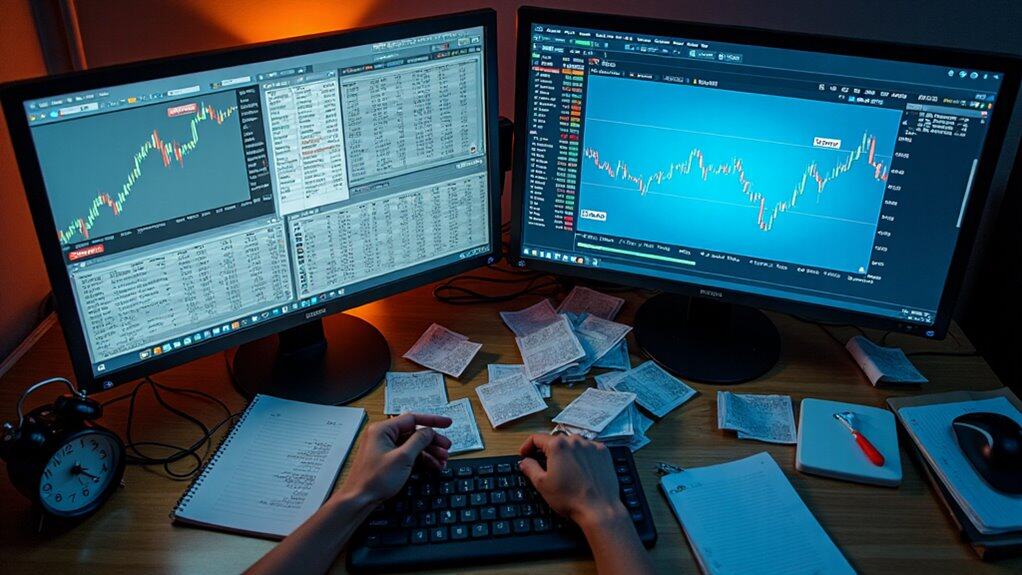You often sabotage trades through emotional reactions like revenge trading after losses or chasing trends with FOMO-driven entries near peaks before reversals. Altering your exit rules mid-trade by moving stops (pre-defined risk controls) violates your plan and locks in bigger losses. Mismatched time frames cause problems, like day traders overwhelmed by minute chart noise. Trying to prematurely pick tops or bottoms leads to false reversals and repeated stop-outs. Critically, ignoring risk management—like risking over 10-20% per trade versus the professional sub-2% standard—causes over 70% of beginners heavy losses from inadequate stops. Less of these common errors reveals further strategies.
Emotional Trading
Emotional trading, while psychologically understandable, converts unplanned reactions into costly trading mistakes. When you lose money on a position, frustration and fear can trigger revenge trading—jumping into an opposing short position—or irrational averaging down, adding to a losing bet hoping it rebounds.
Panic might also make you cancel your stop-loss orders, eliminating your critical pre-defined exit point.
Concurrently, anxiety about missing a profitable move leads to FOMO, prompting you to make late entries near price peaks just before reversals.
This potent mix often escalates into overtrading, a dangerous cycle where emotions consistently push you into impulsive decisions.
Moving the Goal
Shifting predefined exit criteria once a trade moves against you compromises trade discipline. For instance, you might cancel a stop order to avoid realizing a losing trade, hoping markets reverse. Alternatively, you alter technical analysis parameters—like switching from a 5-day to 9-day EMA (Exponential Moving Average) support level—to rationalize holding positions. Both actions violate your trading plan, disregarding pre-set risk management thresholds and amplifying losses.
This behavior turns a manageable small loss into a catastrophic one. Avoid these self-defeating habits:
- Canceling stop orders delays confronting errors, locking you into steep, unexpected drawdowns.
- Redefining analysis mid-trade promotes denial, masking a losing trade’s severity.
- Exceeding risk tolerance sabotages all trading strategy integrity.
- Sidestepping small losses guarantees eventual account erosion.
Trading the Wrong Time Frame
Trading the Wrong Time Frame. Using an unsuitable time frame disrupts your strategy significantly. As a swing trader demanding a 1–6 week holding period, you might impulsively exit due to psychological discomfort with slower gains, abandoning potential profits. Day traders scrutinizing minute charts often process over 300 daily fluctuations, exhausting mental capacity. Position traders on 1-hour charts face frequent false signals, averaging 5-7 misleading reversals weekly, which disrupt multi-day holds. Scalpers with anxiety using 5-minute frames frequently hesitate during pivotal 15-30 second execution windows. Part-time traders commonly miss critical after-hours earnings releases, impacting 38% of swing trades weekly due to mismatched time availability versus strategy needs.
| Mismatched Behavior | Suitable Solution |
|---|---|
| Premature swing exit | Accept designated holding period |
| Fatigue from minute charts | Opt less volatile day trading frames |
| Quitting before target hit | Trust planned strategy exit points |
| Scalp hesitation paralysis | Practice entry simulations |
| Missed earnings releases | Set alerts for key event times |
Trying to Pick Tops or Bottoms
Many traders consistently attempt to time exact market peaks (tops) or dips (bottoms), believing precision guarantees maximum profit. This common mistake ignores market unpredictability, causing losses when reversals fail.
You risk opening short positions prematurely during rallies or a long position before downtrends deepen.
Trying to pick tops or bottoms often involves speculative guesswork, especially when you blindly follow the herd.
Such timing market errors in various markets trigger avoidable losses and missed profitable trades.
- FOMO-Driven Entries: Fear of missing perceived reversals prompts premature trades before confirmation, locking in losses when trends continue.
- Herd-Mentality Pitfalls: Following speculative crowd psychology at suspected tops/bottoms multiplies exposure to false reversals.
- Volatility Drawdowns: Erratic price swings near extremes trigger stop losses repeatedly, eroding capital through tiny cuts.
- Trend Opportunity Costs: Fixating on reversal points makes you bypass strong long/short setups in established directional moves.
Ignoring Risk Management
Although establishing risk rules forms a foundational trading principle, beginners frequently ignore this discipline with damaging repercussions. Ignoring Risk often means risking too much per trade, like 10-20% of capital instead of the professional standard below 2%.
Dumb money loses extensively, with over 70% suffering big losses due to lacking a trailing stop.
Additionally, nearly 80% hold losing trades past exit points, doubling losses from 3% to 6%.
Unmanaged accounts show 30%+ drawdowns versus 10% for disciplined ones, directly linking to poor position sizing.
Almost 60% of margin calls happen after accounts borrow beyond 50% capacity.
Avoid acting emotionally; track choices in a trade journal and cap loss per Every trade. Implement strict risk management like limit orders and sensible position sizing—hallmarks of smart money.
Conclusion
Avoid these key trading mistakes: combat emotional decisions by following structured entry and exit rules (like stop-losses). Stick to predefined goals; switching plans mid-trade harms consistency. Align your time frame analysis (e.g., daily charts) with your strategy and schedule. Never force entries at perceived tops/bottoms; wait for trend confirmations. Prioritize risk management: limit each trade’s risk (e.g., 1% of capital) using defined position sizing. Discipline prevents avoidable losses.


Leave a Reply